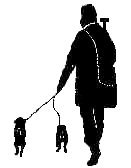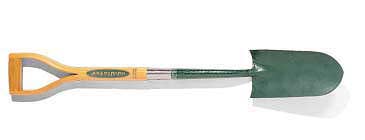
Digging to Your Dog
Slow down.
As odd a piece of advice as that sounds, that's where to start when it comes to digging holes. Most people are too quick to dig, and don't give their dog enough time to push quarry to a stop end or a bolt hole. If you've dug to your dog only to find that the dog has moved farther down the pipe, you are probably guilty of digging too soon -- welcome to the club!
Once you think the dog has worked the quarry to a stop end, and you've located the spot with the deben box, drive in the bar and give it a good rattle. Pound on the ground a bit with the shovel. Then wait a few seconds and box again. If the dog and the quarry are still in the same places, you're ready to dig.
Digging a hole sounds simple enough, but sometimes it isn't. In the U.S., most holes are shallow, which is why we can get away with posthole diggers much of the time. They are a nicety in the dense roots and brush of a hedgerow, but many still prefer to dig with a spade alone.
If your box shows a depth of up to three-and-a-half feet, the quickest way to get to the dog and still have the room you will need to work, is to trench across the pipe about 3 feet long and a spade-head-and-a-half wide. When you get down to within a foot of the pipe, use your bar to locate it, and then use a posthole digger or the spade to carefully cut down cleanly into the pipe. A posthole digger is excellent here because it will remove the dirt cleanly. You will have to overlap the cutting circle of the posthole digger to form a hole that is about 10 inches across. I recommed digging deeper than the pipe, and allowing the dog to push any extra dirt that might fall in into the small "well" that results. Your final result should be a clean hole large enough that you can easily pull the dog when you need to do that.
In truth, most digs require two holes. Often the terrier and the quarry move a bit farther up the pipe just as you break through. This is not a case of the dog moving backwards, but of the dog moving forwards -- often past a turn in the pipe where it had been stymied by the slashing teeth of the quarry as most groundhog, raccoon and fox are able to defend themselves very well at the curve in a tight pipe.
If you find you need to dig another hole, do so, but again wait until the dog has pushed the quarry as far as it can. Pound on the ground one more time before you dig; you want to avoid a third hole if you possibly can.
If you are up to the quarry, it's important to block off the back end of the pipe before you pull the dog in order to prevent the critter from bolting back into the rest of the sette as soon as the dog is clear. This can be accomplished by either collapsing the pipe or by blocking it with a shovel or posthole digger.
Once you pull the dog, you may realize you have to cut the pipe another 8 or 10 inches up towards the quarry in order to either see it for dispatch, or to encourage it to bolt. One way to encourage a bolt is to drive a bar down behind the animal and to give the bar a good rattle -- that is often enough to startle the quarry considerably. If the quarry is right there, simply place a shovel handle in the hole and give it a few minutes to gather its courage. When it starts out, pull your snare as soon as a front leg is through the wire.
Holes deeper than three and a half feet require a different approach, as you will need to be able to get into the hole to pull the dog and dispatch the quarry, otherwise you will find, at the end of the dig, that your arms are too short to reach.
At a depth of four feet, you should be digging a hole that is 4 feet around. If digging deeper than five feet, I recommend a square hole that is five feet on each side as you will have to be able to get the shovel sideways in the hole in order to toss out the dirt. In addition, you will need a large hole because you will be standing on one side of the hole while digging out the other side.
The deeper the hole, the more important it is to keep the sides square and to level off the bottom of the hole as you dig. At depths greater than 6 feet, the danger of collapse has to be paid attention to, as does the logistics of clearing the hole with the dirt. Having someone top-side to move spoil back from the edge is an excellent idea.
In holes that are deeper than six feet, you will want to cut footholes into the wall in order to be able to get out.
After a dig please take time to fill in holes, and in hedgerows or forest settes, please jam sticks and branches crosswise into the hole so that the den pipe is preserved and protected and not solid with dirt when refilled. Most dens will eventually be reoccupied again, and the more dens that remain intact, the more likely your farms will remain productive for seasons to come.
